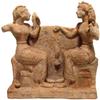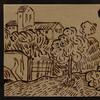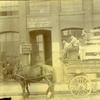The Colonial Williamsburg Foundation Receives Gift of Rare Navajo Chief's Blanket
- WILLIAMSBURG, Virginia
- /
- November 01, 2021
As America honors Native American Heritage Month in November, The Colonial Williamsburg Foundation announces that it has received a rare Navajo First Phase Chief’s Blanket from the late classic period (1865-1870) in the terraced style. The weaving is the first of its kind to enter the Foundation’s collection and joins two Navajo pictorial weavings that were acquired in 2019.
“The Art Museums of Colonial Williamsburg seek to tell a broad and inclusive story of early American culture through the study and display of objects made and used by all the peoples of what is now the United States,” said Ronald L. Hurst, the Foundation’s Chief Curator and Vice President for Museums, Preservation, and Historic Resources. “At the institution’s Abby Aldrich Rockefeller Folk Art Museum, American Indian pottery, basketry, and textiles will help us to share the contributions of indigenous peoples. This Chief’s Blanket comes as a major contribution to that effort.”
For generations, anonymous Navajo women working on hand looms created brilliantly colored, boldly designed pictorial blankets and rugs as was their longstanding cultural and artistic tradition. The earliest of Navajo weavings were blankets to be worn, known as “chief blankets,” made with a simple, horizontally striped and banded design and format. The weavers adapted and modified their work from the world around them and created an art form that is uniquely theirs and provides insight into the Navajo culture at the turn of the 19th century. As the chief blankets were made for wear, many did not survive.
This example is a rectangular weaving of one panel produced in native handspun wool and raveled wool in salmon (aniline dye), blue (indigo dye) and the natural wool colors of brown and white. The pattern from the top consists of a stripe of salmon with a blue terraced design followed by a stripe of white, alternating stripes of brown and white form the body of the blanket with another stripe of salmon with blue terraced design in the middle and at the bottom. Small self-tassels are attached at each corner.
“This chief’s blanket is a beautiful specimen of weaving,” said Kimberly Smith Ivey, Colonial Williamsburg’s senior curator of textiles. “It’s finely woven, and the blanket itself feels almost like silk. The beautiful deep indigo blue stripes are hard to capture in a photograph, but are stunning in natural light.”
This unique textile is a gift from Rex and Pat Lucke, American folk art enthusiasts who have been fascinated for many years with the artistic expression of Navajo weavers. The Luckes, who began collecting antiques, folk art and other artifacts in the early 1970s, discovered Navajo weavings while visiting an American Indian arts gallery in Scottsdale, Arizona, and thought it would be a fitting addition to their folk art collection. Today, the Luckes enjoy living among their collections in their Nebraska home.
“We are pleased to be able to donate this blanket to the Art Museums of Colonial Williamsburg. It was a significant item in our collection, and the Art Museums will be a great home for it,” said Rex and Pat Lucke. “The artistic and weaving skill of the Native American weaver who blended the Grecian Key design with the Navajo’s traditional First Phase Pattern is obvious, and it is a testament to the weavers who were able to expand their horizons during this historic Late Classic Period. We are confident visitors will appreciate seeing it during periods when it is on display in the Art Museums.”
Although this gift is not currently on display at the Art Museums, Navajo Weavings: Adapting Tradition, a new exhibition that opened in September, can be seen at the Abby Aldrich Rockefeller Folk Art Museum through December 2022. Navajo Weavings features six extraordinary weavings from the Lucke Collection, none of which have been displayed at Colonial Williamsburg before.
Additional information about the Art Museums and Colonial Williamsburg as well as tickets are available online at colonialwilliamsburg.org, by calling (855) 296-6627 and by following Colonial Williamsburg on Facebook and @colonialwmsburg on Twitter and Instagram.
About the Art Museums of Colonial Williamsburg
The Art Museums of Colonial Williamsburg include the Abby Aldrich Rockefeller Folk Art Museum and the DeWitt Wallace Decorative Arts Museum, both of which are housed in their newly expanded building that offers an additional 65,000-square-feet of space, 25-percent more gallery space and numerous enhancements to the visitor experience. The Abby Aldrich Rockefeller Folk Art Museum is home to the nation’s premier collection of American folk art, with more than 7,000 folk art objects made up to the present day. The DeWitt Wallace Decorative Arts Museum exhibits the best in British and American fine and decorative arts from 1670–1840. The Art Museums of Colonial Williamsburg are located at 301 South Nassau Street in Williamsburg, Va. Open daily from 9:00 A.M. to 6:00 P.M.
About The Colonial Williamsburg Foundation
Colonial Williamsburg operates the world’s largest living history museum, preserving Virginia’s 18th-century capital as a fully functioning city. Fun, engaging experiences transport guests back in time and highlight the relevance of America’s founding era to contemporary life. The Colonial Williamsburg experience includes more than 600 restored or reconstructed buildings, historic trade shops, renowned museums of decorative arts and folk art, extensive educational outreach programs for students and teachers, lodging, culinary options from historic taverns to casual or elegant dining, the Golden Horseshoe Golf Club featuring 45 holes designed by Robert Trent Jones Sr. and his son Rees Jones, a full-service spa and fitness center managed by Trilogy Spa, pools, retail stores and gardens. Philanthropic support and revenue from admissions, products and hospitality operations sustain Colonial Williamsburg’s educational programs and preservation initiatives. The Colonial Williamsburg Foundation is a 501 (c)(3) nonprofit organization; philanthropic support and revenue from admissions, products and operations sustain its educational programs and preservation initiatives.
# # #
Contact:
Robyn LiverantRobyn Liverant Public Relations
robyn@robynliverant.com







100x100_n.jpg)














